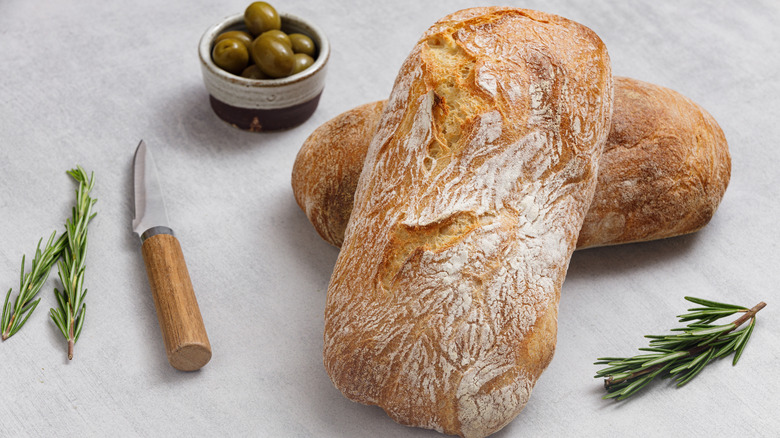Ciabatta Bread Was Invented To Spite The French
Ciabatta certainly seems like something old-fashioned. It's incredibly simple, charmingly misshapen, and crusty. When you think of "rustic" as a selling point for bread, ciabatta looks like exactly the kind of loaf you'd expect. It looks most at home sliced next to a mound of olives and a saucer of good olive oil – a picture of classic Mediterranean cuisine — but it also makes a good sandwich bread. As far as food goes, ciabatta is actually pretty new, and that is likely because it's a bread born of market competition just as much as tradition.
It's really no surprise France and Italy might see each other as culinary rivals; the cultures share a lot of common loves and a reputation for quality and prestige. France and Italy are the top two wine exporters in the world, according to Alibaba. And while you might think the home of Brie and Camembert would be the king of cheese, Italy has actually produced over 2,500 varieties of cheese, says Fennec and Friends. Then, when it comes to bread, France has brioche and country miche, and Italy has focaccia and pane toscano. So when it came to making the perfect everyday Italian bread, you know that Italy was not going to let the French outdo them.
Ciabatta was an answer to the popular baguette
In 1982, Italian bread makers had a problem: Crusty French baguettes were gaining in popularity throughout the country and taking over the all-important role of sandwich bread over Italy's native styles. This is where ciabatta came to the rescue. According to The Guardian, a baker from the Veneto region named Arnaldo Cavallari worked for weeks testing recipes to find something that could compete with the baguette as a tasty multi-use bread. He finally hit the nail on the head with a formulation that included an extremely high-hydration dough and finished baking with large irregular holes. He named the bread ciabatta after the Italian word for slipper — because of its appearance.
From there, ciabatta bread blew up, Cavallari licensed out production of his creation early on, and it quickly expanded to markets outside Italy. Cavallari was its biggest booster, with Fodor's Travel saying he traveled the world teaching the ciabatta recipe to bakers. By the late 1980s, only a few years after its introduction in Italy, it was already on the way to conquering grocery store shelves in the United States and the United Kingdom.
It's easy to see why. Ciabatta matches a baguette's crunchy, airy appeal, but with a wider shape that makes it unbeatable as a canvas for deli meats and breakfast sandwiches. In the world of bread, older doesn't always mean better.

